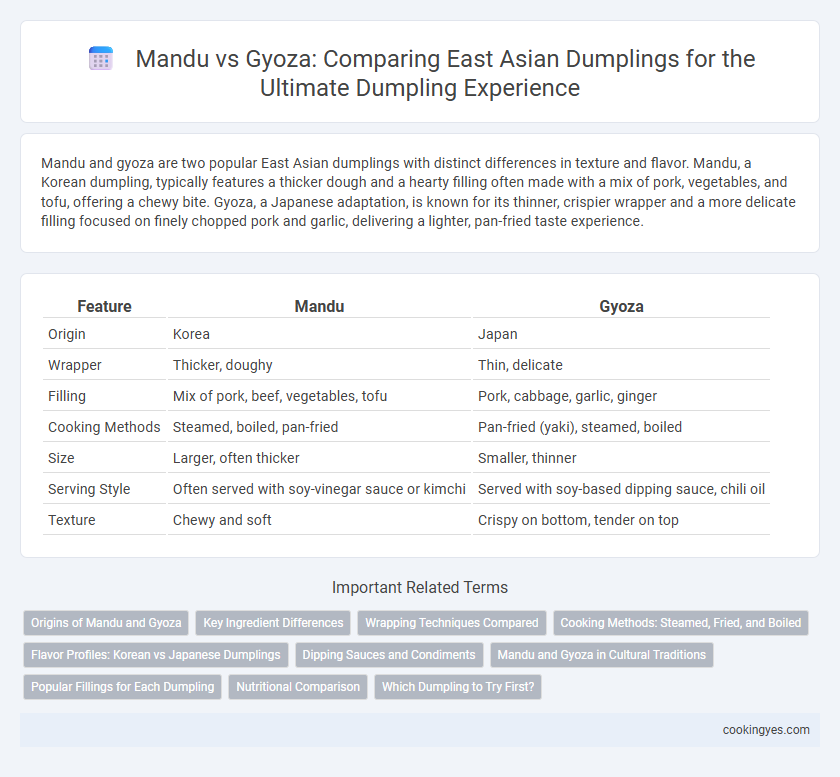Mandu and gyoza are two popular East Asian dumplings with distinct differences in texture and flavor. Mandu, a Korean dumpling, typically features a thicker dough and a hearty filling often made with a mix of pork, vegetables, and tofu, offering a chewy bite. Gyoza, a Japanese adaptation, is known for its thinner, crispier wrapper and a more delicate filling focused on finely chopped pork and garlic, delivering a lighter, pan-fried taste experience.
Table of Comparison
| Feature | Mandu | Gyoza |
|---|---|---|
| Origin | Korea | Japan |
| Wrapper | Thicker, doughy | Thin, delicate |
| Filling | Mix of pork, beef, vegetables, tofu | Pork, cabbage, garlic, ginger |
| Cooking Methods | Steamed, boiled, pan-fried | Pan-fried (yaki), steamed, boiled |
| Size | Larger, often thicker | Smaller, thinner |
| Serving Style | Often served with soy-vinegar sauce or kimchi | Served with soy-based dipping sauce, chili oil |
| Texture | Chewy and soft | Crispy on bottom, tender on top |
Origins of Mandu and Gyoza
Mandu, a traditional Korean dumpling, traces its origins to the Mongol invasions during the 13th century, blending Central Asian and East Asian culinary influences. Gyoza, originating from Chinese jiaozi, was introduced to Japan in the early 20th century, evolving into a thinner, pan-fried version that emphasizes crispiness and a savory pork filling. Both dumplings showcase unique regional adaptations, reflecting distinct historical and cultural exchanges across East Asia.
Key Ingredient Differences
Mandu, a Korean dumpling, primarily features a filling of ground pork, tofu, kimchi, and garlic chives, creating a robust umami flavor with a spicy kick. Gyoza, the Japanese variant, emphasizes finely minced pork mixed with cabbage, garlic, and ginger, resulting in a lighter, more aromatic taste profile. Both dumplings use similar wheat-based wrappers, but the filling ingredients distinguish Mandu's bold, hearty character from Gyoza's delicate, savory balance.
Wrapping Techniques Compared
Mandu and Gyoza differ notably in their wrapping techniques, with Mandu typically featuring thicker, chewier dough that is folded into larger, round or crescent shapes, often pinched with distinctive pleats to secure hearty fillings. Gyoza wrappers are thinner and more delicate, allowing for a lighter, crispier texture after cooking, commonly sealed with a series of fine pleats along one side to create a half-moon shape. These wrapping distinctions influence cooking methods and texture, with Mandu favoring boiling or steaming and Gyoza frequently pan-fried to achieve a crisp bottom.
Cooking Methods: Steamed, Fried, and Boiled
Mandu and gyoza, iconic East Asian dumplings, showcase diverse cooking methods including steaming, frying, and boiling to enhance flavor and texture. Steamed mandu offers a soft, chewy bite, while fried gyoza delivers a crispy, golden exterior contrasted with tender interiors. Both dumplings also boast boiled variants, emphasizing moist, supple dough encasing savory fillings that highlight their distinct regional culinary traditions.
Flavor Profiles: Korean vs Japanese Dumplings
Mandu, Korean dumplings, exhibit a bold and savory flavor profile often enhanced with garlic, ginger, and sesame oil, combined with fillings like kimchi, tofu, or pork, resulting in a robust and spicy taste. Gyoza, Japanese dumplings, feature a lighter, more delicate flavor, typically filled with ground pork, cabbage, and scallions, seasoned with soy sauce, garlic, and ginger for a subtle umami experience. The contrast highlights Mandu's hearty, aromatic complexity versus Gyoza's crisp, balanced, and mildly fragrant character in East Asian dumpling cuisine.
Dipping Sauces and Condiments
Mandu and gyoza feature distinct dipping sauces that highlight their unique flavors within East Asian cuisine. Mandu is typically paired with a soy sauce-based dip mixed with vinegar, garlic, and chili oil, offering a balanced combination of tangy and spicy notes. Gyoza sauce emphasizes a sweeter and lighter soy sauce blended with rice vinegar and sesame oil, complemented by finely chopped scallions and sometimes grated ginger.
Mandu and Gyoza in Cultural Traditions
Mandu, a traditional Korean dumpling, is often enjoyed during Lunar New Year celebrations and Chuseok, symbolizing good fortune and family unity, while gyoza, a Japanese dumpling influenced by Chinese jiaozi, is commonly served as a popular appetizer in casual dining and izakayas. Mandu typically features a variety of fillings such as kimchi, pork, and tofu, reflecting Korea's bold and spicy flavors, contrasting with gyoza's more delicate blend of ground pork, cabbage, and garlic. Both dumplings hold significant cultural value, with mandu representing a festive dish for communal gatherings and gyoza embodying everyday comfort food in Japanese cuisine.
Popular Fillings for Each Dumpling
Mandu, a Korean dumpling, commonly features fillings such as ground pork, kimchi, tofu, garlic, and scallions, offering a robust, spicy flavor profile. In contrast, Japanese gyoza typically contains a mixture of ground pork, cabbage, garlic, ginger, and chives, resulting in a lighter and more savory taste. Both dumplings emphasize fresh vegetables and pork, but mandu distinguishes itself with kimchi while gyoza incorporates ginger for aromatic depth.
Nutritional Comparison
Mandu and gyoza are traditional East Asian dumplings with distinct nutritional profiles influenced by their fillings and preparation methods. Mandu, typically filled with minced pork, tofu, and vegetables, often contains higher protein and fat content compared to gyoza, which usually features leaner ground pork or chicken with cabbage and garlic chives. Steamed or boiled mandu provides lower calorie options, while pan-fried gyoza tend to have increased fat and calorie levels due to cooking oil absorption.
Which Dumpling to Try First?
Mandu, a Korean dumpling, features thicker dough and a heartier filling often including tofu, kimchi, and pork, offering a rich, savory experience. Gyoza, a Japanese favorite, uses thinner wrappers and is typically pan-fried, delivering a crispy texture with a lighter pork and vegetable filling. For beginners exploring East Asian dumplings, try gyoza first for its approachable flavor and crisp bite, then move to mandu for a more robust, chewy texture and complex seasoning.
Mandu vs Gyoza for East Asian dumplings Infographic

 cookingyes.com
cookingyes.com